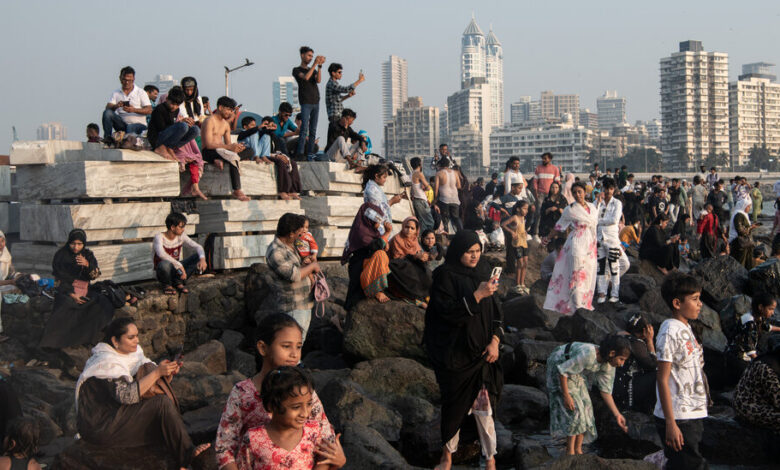Wall Street Lands on India, Looking for Profits It Can’t Find in China

Mumbai, India’s financial capital, has seen a lot of new faces over the past year. The heads of global banks have been trooping through, visiting its stock exchanges, buying property and hiring new staff.
A postpandemic boom has pushed the value of India’s stock market to about $5 trillion, putting it neck and neck with Hong Kong’s. India’s economy is among the fastest growing in the world. Wall Street can’t ignore India anymore.
The point of entry is Mumbai, a port city of 26 million people, counting its suburbs. Mumbai has been given a makeover: Suspension bridges span its seaways, as well as its infamous slums, and new metro lines have been carved beneath its Art Deco and Indo-Saracenic facades and rumbling commuter railways.
Mumbai has been India’s commercial hub for eight decades, but it was relatively unfamiliar to global finance until the past two years.
Now North American pension managers, sovereign wealth funds from the Persian Gulf and Singapore, Japanese banks and private equity firms are clamoring for a piece of India’s growth. Old hands and novices alike can rattle off reasons India’s rise is inevitable.
Making money will be easier said than done, not least because Indian investors got here first. Compared with Indian companies’ current profits, their stock prices are high.
Foreign investors have yet to throw in their full financial weight. Mumbai’s markets were jittery in May, as Narendra Modi, the pro-business prime minister, fought for re-election. He is expected to win, but uncertainties have made far-flung investors feel cautious.
Despite all the hot money pouring into the Mumbai markets, India remains a tricky place for foreign companies to navigate, making direct investment risky. Demand for spending by India’s potentially vast base of consumers has been lagging expectations — the top of the income ladder is spending more than ever, while hundreds of millions of people are stuck near the bottom.
The simple reason for investors’ enthusiasm is India’s economy, which has strengths other big emerging economies are currently lacking. Foreign clients, an Indian bank executive said, “gravitate to India because it is showing reliable growth, its currency is stable, it’s showing fiscal discipline.” He spoke on the condition of anonymity because he works closely with the government.
If India looks better to global investors, China and Russia look worse. China’s miraculous growth engine is sputtering, after three decades at full throttle, with threats of trade wars becoming routine. And Russia was effectively crossed off some lists of viable emerging economies after its invasion of Ukraine in 2022 and the sanctions imposed on it by the United States, Europe and their allies.
That is one reason, the banker said, investors pushed Wall Street to make it easier to bet big sums of money on India.
The MSCI, an influential stock index of emerging markets started by Morgan Stanley, has increased India’s weighting to more than 18 percent, from 8 percent in 2020, while reducing China’s representation. It’s not just stocks: In June, JPMorgan Chase will add Indian government bonds to its emerging-markets index. Both changes mean that mutual funds are buying more Indian financial assets.
Aashish Agarwal, the managing director in charge of India for the investment bank Jefferies, has been doing deals in Mumbai for more than 20 years. He said the case for investing in India was a no-brainer: Indian stocks are outperforming China’s. India’s markets also draw on a wider range of companies than many other emerging economies, he said.
“You can’t think of Korea without Samsung, or Latin America without commodities,” Mr. Agarwal said. “India, as an index, is arguably the most balanced you might find outside of the U.S.”
The view looks equally sunny to Kevin Carter from Lafayette, Calif. He founded an investment firm, called EMQQ Global, that sells exchange-traded funds, which make it easy for ordinary people to invest in emerging markets. The value of one fund that focuses on India’s internet and e-commerce sectors has grown nearly 40 percent in the past year.
India, he said, has the makings of what historically has helped emerging markets to succeed: a large population, especially of young people, and economic growth that is causing people to spend more.
With 1.4 billion people and counting, India is the world’s most populous country. Most Indians are working age or will be soon, unlike residents of Europe or East Asia. India’s economic growth rate, hovering around 7 percent, compares favorably with a world average of 3.2.
For some investors, there is an air of déjà vu. They remember a time almost 15 years ago when India was last thought to be ready to overtake China’s rate of economic growth.
Those who bought the India hype then ended up disappointed. From 2008 to 2020, China’s per-capita income quadrupled while India’s grew by 2.5 times. That left India poor compared with the rest of the world.
The latest calculation by the International Monetary Fund placed India at 138 in national rankings of income, between the Republic of Congo and Nicaragua. China was in 65th place. But India is moving up, a lot faster than China can.
Along the way, India is spending heavily on public infrastructure, a hallmark of Mr. Modi’s policies in 10 years in office.
In Mumbai itself, there were just three skyscrapers in 2008 — it will have sprouted hundreds by the end of this year. The city’s center of gravity has shifted from its downtown to the purpose-built Bandra Kurla Complex, or BKC, a midtown sprawl of concrete spaghetti. The One BKC tower, home to Bank of America and Switzerland’s insurance giant Swiss Re, as well as many others, was bought by Blackstone, the world’s biggest private-equity group, for a reported $300 million in 2019.
Mumbai, of course, is also home to the stock market, which has attracted the savings of India’s own rapidly expanding investor class. Banks have made it easier for middle-income Indian families to invest directly. So many newbie investors have lost money on the risky trading of derivatives — investment securities tied to other securities — that the regulators want to rein them back in.
A stiffer test for India’s economy will be whether it can draw more foreign direct investment — the buying up of whole chunks of private businesses by investors or companies.
Nivruti Rai, managing director of Invest India, a joint venture between the commerce ministry and private chambers of commerce, is trying to ease the way. Ms. Rai is well positioned for the job, having spent nearly 30 years at Intel, spanning India and America.
“I am a woman, I come from tech, from a multinational,” she said, “and I’m based in India. All this sends a message.”
More longer-term foreign funding would help strengthen and stabilize the Indian rupee. Investors who make such financial commitments also tend to bring technical expertise.
“We may be missing on capital and, in some places, we may be missing on technology,” she said.
Ms. Rai has a lofty target — $100 billion in foreign direct investment. That’s higher than what India drew in 2021, which was a record, and much higher than it is now. The inflow sank 16.8 percent last year to just over $28 billion. Foreign investment shrank in many spots around the world in 2023, but India, like China, was hit especially hard. Ms. Rai nonetheless foresees a new cycle of investment activity centered on Indian companies in health care technology, clean energy and artificial intelligence.
Mr. Modi has promised a tenfold increase in India’s economy by 2047, in time for the 100th anniversary of its independence. To get there, Ms. Rai noted, the country will need an even faster rate of growth, and that means more of “these investors that we’re trying to draw in.”



